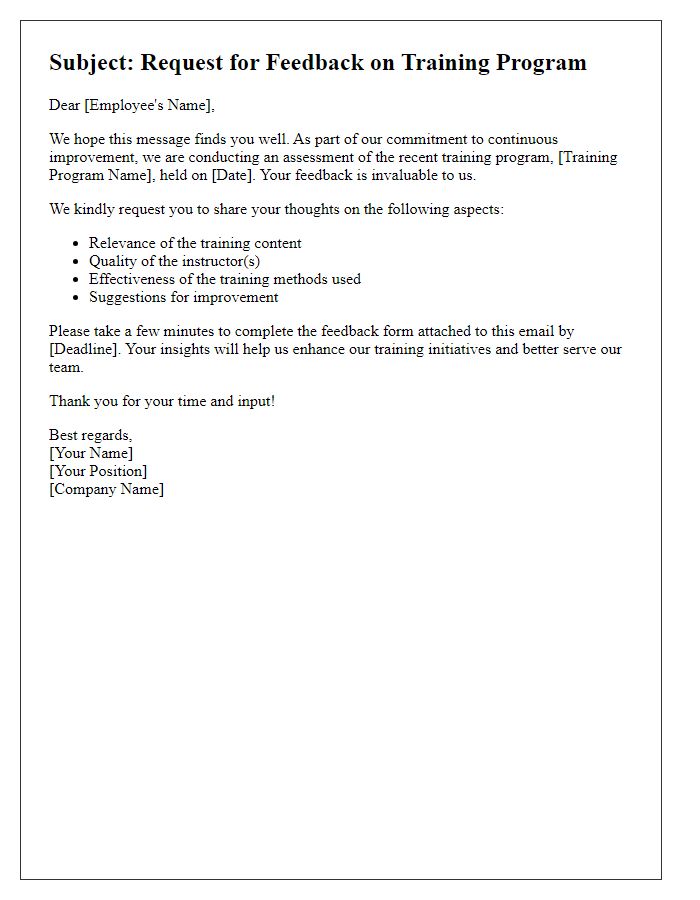Hey there! Are you looking to gather valuable insights from your team? Creating a letter for an employee feedback request is an essential step in fostering a culture of open communication and continuous improvement. In this piece, we'll explore how to craft a thoughtful and engaging request that encourages honest feedback, helping to enhance both individual and organizational growth. So, let's dive in and discover how you can effectively connect with your employees and invite their valuable contributions!

Clear Purpose
Employee feedback is crucial for enhancing workplace culture and improving productivity. When organizations like Google prioritize feedback from team members, it fosters a collaborative environment. Regular check-ins and surveys, such as the Employee Engagement Survey conducted annually, reveal key areas for growth and development. Constructive feedback aims to identify strengths and weaknesses in various departments, such as Engineering or Marketing, impacting overall performance. Fostering an open dialogue not only empowers employees but also encourages innovation and creativity, leading to improved project outcomes and employee satisfaction.
Professional Tone
A formal employee feedback request promotes a culture of open communication and continuous improvement. The objective is to solicit constructive insights regarding team dynamics and performance. The request should include a deadline for responses, typically one week, to ensure timely feedback. It is crucial to specify the areas of focus, such as collaboration, project management, or leadership qualities, to guide the feedback process. Additionally, ensuring anonymity can encourage honest responses while highlighting the importance of feedback in professional development. Encouragement for high-quality, actionable feedback is essential to foster an environment of growth and accountability.
Specific Guidance
Employee feedback is crucial for organizational development and employee growth. Specific guidance on performance can foster a culture of continuous improvement. For example, regular assessments, such as quarterly reviews, can highlight individual contributions and areas needing growth. Utilizing structured feedback forms can streamline the process, ensuring that employees understand expectations and can voice their concerns. Conducting these evaluations in setting environments, like team meetings or one-on-one sessions, can enhance transparency and trust, creating a supportive atmosphere for open discussions. Feedback on goals, teamwork, and leadership can drive personal accountability, engagement, and overall job satisfaction.
Confidentiality Assurance
Confidentiality Assurance is a critical aspect of employee feedback mechanisms in organizational settings, often seen in companies prioritizing workplace culture. Implementing secure channels (like encrypted email or anonymous online surveys) ensures that employee responses remain private, fostering trust and open communication. Organizations, including tech giants like Google and Microsoft, utilize targeted feedback tools to gather insights while safeguarding personal data (critically necessary under regulations like GDPR). Ensuring anonymity can unlock valuable feedback, revealing essential themes in employee satisfaction. Additionally, clear communication regarding how feedback will be used strengthens relationships between management and staff, promoting a culture of continuous improvement and engagement.
Actionable Follow-Up
Requesting employee feedback is crucial for enhancing workplace dynamics. Implementing structured surveys can foster open communication within the team structure, facilitating the collection of valuable insights. The feedback process should encompass specific areas, such as job satisfaction, team collaboration, and leadership effectiveness. Designing a comprehensive questionnaire, featuring both quantitative ratings and qualitative open-ended questions, can yield actionable data. Setting a timeline for feedback submission, ideally within two weeks, ensures prompt responses. Analyzing the collected feedback thoroughly can guide management decisions, leading to targeted improvements in employee engagement and productivity.
Letter Template For Employee Feedback Request Samples
Letter template of employee feedback request for team collaboration insights.

Letter template of employee feedback request for training program assessment.

Letter template of employee feedback request for leadership development input.

Letter template of employee feedback request for workplace satisfaction survey.

Letter template of employee feedback request for policy changes suggestions.

Letter template of employee feedback request for onboarding experience review.

Letter template of employee feedback request for diversity and inclusion efforts.







Comments